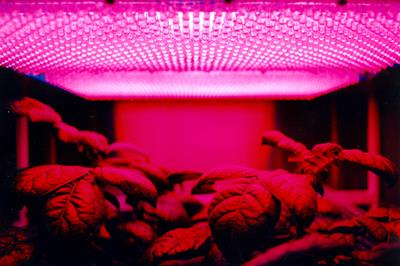
Saturday October 17, 2015
Updated on 8/2/2021
View our Editorial PolicyThis content contains third-party advertisements. Click here to view PotGuide's advertising policy
 Growing
Growing
Alaska, Colorado and Oregon allow personal cannabis cultivation for recreational users and at least a dozen more allow it for medical patients. Weather permitting, marijuana can be grown outdoors, but during the long winter months, it’s either grow it indoors or not at all.
Though certainly not as easy to grow as basil on a window sill, marijuana can be grown indoors for relatively little cost. In addition to seeds (or clones), a growing medium and a secure location, marijuana grow lights will be an important investment in the grow process and come in a wide range of varieties and prices.
Grow Lights for Cannabis Plants: What to Look For
Plants absorb light through a process called photosynthesis which transforms light energy into the chemical energy needed to grow. Different light sources produce different colors, each with varying wavelengths and energy output.
For the best experience growing marijuana, specific light requirements must be met. It is not enough to shine a bright light on the plant and be done with it. To get the best yield from marijuana grow lights, it is important to consider the following:
-
Color
Light waves come in a spectrum of colors. Blue waves are smaller and contain more energy while red light waves are longer with less energy. Blue lights are ideal for vegetative growth and red lights for the flowering stage. Full-spectrum lights (like the sun) contain all colors and therefore appear white.
-
Intensity
Light intensity is measured in Lumens and determines how much light can be absorbed by the plant itself. Lights with low intensity tend to produce long and stringy plants as they stretch to find sufficient light while plants under high intensity light tend to grow shorter and bushier with higher yields. Light intensity can be slightly adjusted by changing its distance from the plant.
-
Duration
The vegetative stage of cannabis growth requires a longer duration of light (usually between 13 and 18 hours or more) while the flower stage requires an even amount of light and dark. Outdoors this happens naturally, but indoor grows should use timers to keep plants on the right cycle thus reducing the risk of plant stress (which could result in seedy buds).
Different Types of Indoor Grow Lights
-
Florescent Grow Lights (CFLs, tube lights)
These energy-efficient lights can come in cool, warm or the full-spectrum of colors. Though penetration is less intense, these lights are a great option for anyone worried about temperature control or electrical usage. It is important to note that because they lack intensity, resulting buds will be small and fluffy rather than the dense, trichome-covered beauties you’ll find in a dispensary.
To make up for their poor penetration, lights must be kept close to the plant (within about 3”) and multiple lights will be required to cover the whole plant. The good news is that there are no extra parts other than the right fixture which makes florescent lights great for novice growers. As the grow room expands, fluorescent grow lights can also be used to supplement other lighting options as well. The price of florescent bulbs range from just a few dollars to a few hundred and may require a specialized fixture, as well.
-
LED Grow Lights
LED lights are gaining in popularity because they are energy efficient, relatively cool to the touch, require no extra components and are available in a full spectrum of colors. They only cover a small space, however (so you may require more of them), and are less intense which could result in smaller, less dense buds. Though you can use full-spectrum LED lights for an entire grow cycle, many professional growers prefer to use them as supplemental lighting because they are low maintenance, cost efficient, and have a relatively long lifespan of around 10 years if kept on a 12/12 cycle. Used in conjunction with High Density Discharge lights, LED lights can help produce dispensary-quality buds for relatively little cost.
The average cost of LED grow lights ranges from just under $100 to a few thousand. Please note that not all LED lights are suitable as grow lights. Check with the manufacturer before making a purchase.
-
High Intensity Discharge lights (High Pressure Sodium [HPS] or Metal Halide [MH])
These high intensity bulbs are a favorite among professional growers because they result in bigger, denser buds every time. Bulbs tend to get very hot, which increases the need for ventilation and temperature control. There are also more components required to run HID lights including bulbs (both MH and HPS for full a growth cycle), specific lighting fixtures, ballasts (to mediate the electrical current), ventilation and temperature control. Bulbs must also be replaced occasionally which makes the use of HID lights an on-going investment.
The price of an HID lighting setup can start as low as a few hundred dollars used to upwards of $1,000 or more for the whole set-up.
Growing your own marijuana is a wonderful experience and a great way to celebrate our newfound freedom to medicate and enjoy cannabis. If you do grow your own, then choose your lights carefully and expand as you see fit. Growbuds has an excellent selection of different lighting rigs to choose from across each of the different types above, with a range of pricing options to fit your needs. Happy Growing!
Do you have any growing tips you’d like to share? We’d love to hear them!
Photo Credit: Ras67 (Public Domain)








